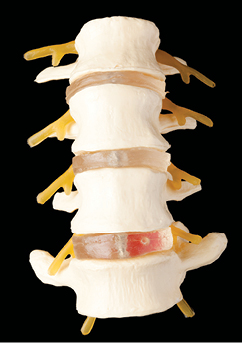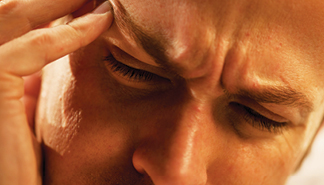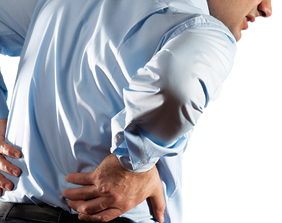Introduction
:dropcap_open:H:dropcap_close:ealth care costs have been rising for several years. Expenditures in the United States on health care surpassed $2.3 trillion in 2008, more than three times the $714 billion spent in 1990, and over eight times the $253 billion spent in 1980. Stemming this growth has become a major policy priority as the government, employers, and consumers increasingly struggle to keep up with health care costs.1 A study performed by a large managed care system demonstrated that systematic access to chiropractic care for neuromusculoskeletal conditions might be clinically beneficial and reduce the overall costs of medical care.2
 Back pain accounts for more than $100 billion in annual US health care costs and is the second leading cause of physician visits and hospitalizations. 3 Low back pain is a very common condition, accounting for 2.3% of physician visits in the United States.4 While lumbar disc prolapse, protrusion, or extrusion accounts for less than 5% of all low back problems, it is the most common cause of nerve root pain and surgical interventions.5
Back pain accounts for more than $100 billion in annual US health care costs and is the second leading cause of physician visits and hospitalizations. 3 Low back pain is a very common condition, accounting for 2.3% of physician visits in the United States.4 While lumbar disc prolapse, protrusion, or extrusion accounts for less than 5% of all low back problems, it is the most common cause of nerve root pain and surgical interventions.5
Chiropractors and their patients recognize the value of chiropractic interventions for the treatment of low back pain and now orthopedic surgeons are acknowledging the effectiveness of chiropractic care. According to an orthopedic surgeon at the Texas Back Institute, chiropractic spinal manipulation is a safe and effective treatment for spinal pain.
It reduces pain, decreases medication needed, rapidly advances physical therapy, and requires very few passive forms of treatment, such as bed rest. Jack Zigler, MD, orthopedic spine surgeon with the Texas Back Institute, states, “There are a lot of myths about chiropractic care. I decided to look into each of these myths, and what I found is that chiropractic education, side-by-side, is more similar to medical education than it is dissimilar.
Chiropractors work for us as screeners for surgical pathology. They can do the same work-up and send the patient who has already gone through his conservative treatment and had all his diagnostic work done to the surgeon.” 6
The National Prevention Strategy promulgates a vision of an interdisciplinary care system with chiropractors and medical doctors working together to improve the health and quality of life for individuals, families, and communities by moving the nation from a focus on sickness and disease to one on prevention and wellness.7
This putative case report provides the reader with a clinical learning opportunity that might improve treatment of low back pain. The discussion addresses certain aspects of the evaluation and management process and proper documentation of the intervention. I will demonstrate a reasonable approach to the examination and differential diagnosis of lumbar sprain/strain with resultant lumbar discopathy and lumbar radiculopathy and offer a prudent treatment plan.
Subjective:
Chief Concern: “I have low back pain and numbness in the leg”
“Two weeks ago, I was lifting a freezer and hurt my back.” The patient described the incident as follows: “I was in the back of a pickup truck and my friend was on the ground holding the other end of his new freezer. I lost my balance while holding the freezer and felt a sharp pain in my back. The freezer dropped and then I jumped off the back of the truck. When my feet hit the ground, I almost passed out from the terrible pain.” The patient’s wife attended and assisted with the history taking process. He was a bit confused and agitated.
He complains of sharp, shooting pain in the lower back that shoots down the back of the right lower extremity to the calf with coughing, sneezing or having a bowel movement. Prolonged sitting increases the pain in his back and causes numbness of the right calf and the dorsum of the foot. Taking NSAIDS, sitting in his reclining chair and alcoholic beverages reduce the pain. For the past week, he has noticed that he stubs his toes of the right foot when walking for more than a block. The worst pain experienced occurs with sitting and bending down to pick up his shoes. He rated this pain at 9/10. He has difficulty sleeping through the night. Movement in bed increases back pain. Upon waking, he experiences stiffness in the back. He uses medications and ice on his back at night to sleep. His pain reduced to 3-4/10 while resting and increased to 7-8/10 with cough or sneeze.
His primary care provider (PCP) told him that he “pulled” his back muscles. The three view lumbar radiographic study (A-P, lateral and spot of L5) impression by the radiologist was “Moderate disc space narrowing at L5-S1 but negative for fracture or pathology.” This study dated last week included the radiographs and the written report. The PCP prescribed Ibuprofen and muscle relaxers. He has never been to a chiropractor but his wife told him to make the appointment. There is no history of back problems. His review of systems did not reveal any history of serious illness or surgical interventions. He has smoked one pack of cigarettes per day for the past 35 years and drinks 2-6 beers per night.
Objective:
General appearance:
This 35-year-old Caucasian male appeared to be in severe pain and was overweight and disheveled. He was cooperative but seemed a bit confused and agitated during the history/interview process. He was aggravated when he could not remember the date of injury when asked. He blamed the confusion on the medications (muscle relaxers).
Posture:
Minor’s sign was present when the patient rose from the chair to stand. The patient’s painful listing to the left revealed the antalgia sign.
Gait:
Painful behavior noted with limping of the right lower extremity (RLE). Heel-walk revealed toe drop of right foot. The toe walk did not demonstrate any weakness.
Palpation:
He demonstrated severe pain reaction with palpation of the right L 5-S1 region on the right and moderate pain reaction with palpation of the L5-S1 supraspinous ligament. Myospasia of the lumbar paravertebral muscles was evident. Pain was present with palpation at the right sciatic notch and at the area of the fibular nerve below the right knee.
Range of motion:
All active range of motion reduced due to the severe pain in the lumbar spine and myospasia of the paraspinal muscles.
Passive range of motion with flexion, extension, right rotation and right lateral flexion produced pain at L5-S1 on the right.
Resisted range of motion increased pain in the lumbar paravertebral muscles with flexion and extension.
Orthopedic tests:
O’Donoghue maneuvers revealed strain of lumbar paraspinal muscles and sprain of the L5-S1 joint/ligaments.
Kemp maneuver demonstrated reduced range of motion and radiating pain down the RLE to the lateral calf.
Valsalva maneuver produced pain at L5-S1 midline and on the right with radiation down RLE to posterior thigh.
Lindner sign present with radiating pain down RLE to the lateral calf.
Straight leg raise (SLR) tests:
Supine SLR RLE produced severe pain at L5-S1 on right to the lateral calf at 45 degrees. Supine SLR LLE at 85 degrees reduced the pain in the RLE. RLE SLR presented Lasegue, Braggard, and Sicard’s signs. Turyn sign absent.
Neurological examination:
Sensory: Sharp, dull and light touch stimulation revealed the upper and lower extremity dermatomes to be intact except for hypesthesia of the right L5 dermatome.
Motor: All upper and lower extremity myotomes tested 5/5 bilaterally except 4/5 of right L5.
Deep tendon reflexes (DTR): 2+ bilaterally for the upper and lower extremities except 1+ with reinforcement of right hamstring reflex.
Babinski sign absent with stimulation of the plantar reflex (toes down going).8
Assessment:
Acute, moderate lumbar sprain/strain with resultant lumbar discopathy and lumbar radiculopathy
Plan:
- Spinal decompression therapy with distraction and manipulation in order to reduce pain and promote function (daily for five treatments).
- Cryotherapy (ice massage) to reduce pain and myospasia to be performed at home.
- Electrotherapy to reduce edema and pain.
- Patient was advised to avoid prolonged sitting and to ambulate frequently.
- He was advised to sleep on back or sides with pillow support of lower extremities.
- Spinal extension and stabilization exercises will be implemented in the subacute phase.
- A smoking cessation and weight loss program was suggested in order to improve overall health and possibly slow the disc degenerative process.
- A neurosurgical consultation is appropriate if he does demonstrate positive response to conservative care within 2 weeks.
Discussion:
An orthopedic test is most often a provocative maneuver with stretching, compressing, and contracting of tissues in order to duplicate the patient’s pain and identify the involved tissues. Clinicians perform tests and observe for signs of dysfunction, pathology or disease.
You may reveal Dejerine signs during the history taking process by posing this simple question: “Do you have the pain with coughing, sneezing or bowel movement?” You may perform a three-part test that requires the patient to sneeze, cough, and perform the Valsalva maneuver. Normally, I do not perform the snuff test (pepper under the nose) to induce sneezing but I do ask the patient to cough. The presence of these three signs is termed a Dejerine Triad. The testing for Dejerine signs determines the presence of nerve root compression, which can arise from osseous foraminal encroachment, disc protrusion (bulging), prolapse (herniation) or severe sprain/strain of the spine.
O’Donoghue maneuvers differentiate sprain from strain or reveal the presence or absence of such soft tissue injuries. Muscle strain injuries will be painful with resisted motion. Ligament sprain or joint injuries will be painful with passive motion.
Antalgia sign with anterior and lateral listing to the left with pain radiating down the RLE suggests the possibility of a posterior lateral disc herniation with a lesion located lateral to the nerve root. If the posterior lateral disc herniation were located medial to the nerve root, the patient would list toward the side of leg pain.
The Kemp maneuver produced radiating pain down the RLE to the lateral calf with extension, rotation and lateral flexion to the right, which also suggests the possibility of disc lesion, which lies laterally to the nerve root.
Straight leg raise testing demonstrated three different nerve-root tension signs (Lasegue, Braggard, and Sicard) and the possibility of a disc lesion located lateral to the nerve root.
A three-part peripheral nervous system examination enables the clinician to determine the presence of upper motor neuron or lower motor neuron lesions. It involves the testing of deep tendon reflexes, sensory function and motor function. In this particular case, the patient presented with weakness of the dorsiflexor muscles of the right foot indicating motor deficit in the L5 myotome. Sensory testing revealed hypesthesia or decreased sensory function in the L5 dermatome.
The 1+ DTR of the right medial hamstring tendon indicated a decrease in response to stroking of the tendon with a reflex instrument, which indicates dysfunction at the level of L5 nerve root. These neurological findings and the absence of the Babinski sign indicate a lower motor neuron lesion involving the L5 nerve root rather than an upper motor neuron lesion, which would involve the spinal cord or brain.
Assessment:
Diagnosis is the key to successful treatment.9 When treating a patient with discopathy and radiculopathy, the clinician must determine the stage of the healing process, the type of injury and tissue involved, and the site of lesion. This patient was determined to be in the acute phase due to the timing of the injury and the major complaint being pain. The lower lumbar muscles and ligaments were overstretched and torn. The L5-S1disc herniation is compressing the L5 nerve root.
Plan:
I prefer the use of spinal decompression equipment that permits manual control and manipulation when treating patients with discopathy and radiculopathy. It is essential to determine if the posterior lateral disc herniation is located lateral or medial to the involved nerve root prior to administering manual methods and spinal decompression. The spinal decompression intervention addressed the multi-directional disc dynamics in order to relieve compression of the spinal nerve roots.
Smoking and being overweight precipitate spinal disc disease.10 A causal relationship exists with nicotine and disc degeneration;11 and smoking with heavy use of alcohol are associated with suicidal ideation.12 I prescribed smoking cessation, weight loss, and alcohol cessation recommendations to improve the health and quality of life for this patient. A caring clinician will promote disease prevention and wellness.
Conclusion:
Chiropractic evaluation and management of lumbar discopathy with radiculopathy requires appropriate examination procedures in order to complete a differential diagnosis and develop a comprehensive treatment plan. If you are interested in providing the most current evidence-based conservative spinal care, I strongly recommend the seventh edition of Low Back Pain: Mechanism, Diagnosis, and Treatment by James M. Cox. I suggest any clinician interested in performing spinal decompression investigate the training offered by experts.13 14
This article may be used to earn CE Credits through the Postgraduate Department at the University of Bridgeport. To learn if your state is eligible, and to register contact Anne Nilson at 203-576-4880 or register on the web at www.bridgeport.edu/tac
James J. Lehman, D.C., M.B.A., D.A.B.C.O. is an Associate Professor of Clinical Sciences at the University of Bridgeport College of Chiropractic. Please remit any questions or comments to [email protected]
References:
- Centers for Medicare and Medicaid Services, Office of the Actuary, National Health Statistics Group, National Health Care Expenditures Data, January 2010.
- Antonio P. Legorreta, MD, MPH, R. Douglas Metz, DC, Craig F. Nelson, DC, MS, Saurabh Ray, PhD, Helen Oster Chernicoff, MD, MSHS, Nicholas A. DiNubile, MD. Comparative Analysis of Individuals With and Without Chiropractic Coverage Patient Characteristics, Utilization, and Costs. Arch Intern Med. 2004;164:1985-1992.
- Katz, J.N. Lumbar disc disorders and low-back pain: socioeconomic factors and consequences. J Bone Joint Surg Am. 2006;88: 21-24.
- Deyo, R.A., Mirza, S.K., Martin, B.I. Back pain prevalence and visit rates: estimates from U.S. national surveys, 2002. Spine. 2006;31:2724-2727.
- Manchikanti, L., Derby, R., Benyamin, R.M., Helm, S., and Hirsch, J.A. A Systematic Review of Mechanical Lumbar Disc Decompression with Nucleoplasty. Pain Physician 2009; 12:561-572 • ISSN 1533-3159.
- Zigler, J. Time to recognize value of chiropractic care? Science and patient satisfaction surveys cite usefulness of spinal manipulation. Orthopedics Today 2003 Feb; 23(2):14-15.
- National Prevention Council, National Prevention Strategy, Washington, DC: U.S. Department of Health and Human Services, Office of the Surgeon General, 2011. [Cited December 3, 2011] Available from: http://www.healthcare.gov/prevention/nphpphc/strategy/report.pdf.
- Russell, S. & Triola, M. NYU School of Medicine. The Precise Neurological Exam. [Cited December 4, 2011] Available from: http://cloud.med.nyu.edu/modules/pub/neurosurgery/reflexes.html.
- Miller, K.J. Physical assessment of lower extremity radiculopathy and sciatica. J Chiropr Med. 2007 Spring; 6(2): 75–82.
- Kaila-Kangas, L., Leino-Arjas, P., Riihimäki, H., Luukkonen, R., Kirjonen, J. Spine (Phila Pa 1976). Smoking and overweight as predictors of hospitalization for back disorders. 2003 Aug 15; 28(16):1860-8.
- Kim, K.S., Yoon, S.T., Park, J.S., Li, J, Park, M.S., Hutton W.C. Inhibition of proteoglycan and type II collagen synthesis of disc nucleus cells by Nicotine. J Neurosurg. 2003 Oct; 99(3 Suppl):291-7.
- Fishbain, D.A., Lewis, J.E., Gao, J., Cole, B., Steele Rosomoff R. Are chronic low back pain patients who smoke at greater risk for suicide ideation? Pain Med. 2009 Mar;10(2):340-6. Epub 2009 Feb 25.
- Cox, J.M. Cox Technic (Flexion Distraction / Cox Technique / Cox Method). [cited December 4, 2011] Available from: http://www.youtube.com/watch?v=sqgNZj25bUk.
- Cuccia D. Spinal Decompression for Herniated Disc with ExtenTrac Technology. [Cited December 4, 2011] Available from: http://video.google.com/videoplay?docid=-6907766059201864758#.


 While health care professionals continue the controversial debate over the classification of cervicogenic headaches, a comprehensive multidisciplinary pain treatment program provides the greatest opportunity for overall clinical improvement.2 Recent evidence suggests that chiropractic care, including spinal manipulation, improves migraine and cervicogenic headaches.3
While health care professionals continue the controversial debate over the classification of cervicogenic headaches, a comprehensive multidisciplinary pain treatment program provides the greatest opportunity for overall clinical improvement.2 Recent evidence suggests that chiropractic care, including spinal manipulation, improves migraine and cervicogenic headaches.3 
 :dropcap_open:C:dropcap_close:
:dropcap_open:C:dropcap_close: This putative case report demonstrates a focused history taking and physical examination process with a patient presenting post-traumatic low back pain. I documented the patient encounter with SOAP notes (an acronym for subjective, objective, assessment, and plan).
This putative case report demonstrates a focused history taking and physical examination process with a patient presenting post-traumatic low back pain. I documented the patient encounter with SOAP notes (an acronym for subjective, objective, assessment, and plan).
 :dropcap_open:I:dropcap_close:n
:dropcap_open:I:dropcap_close:n